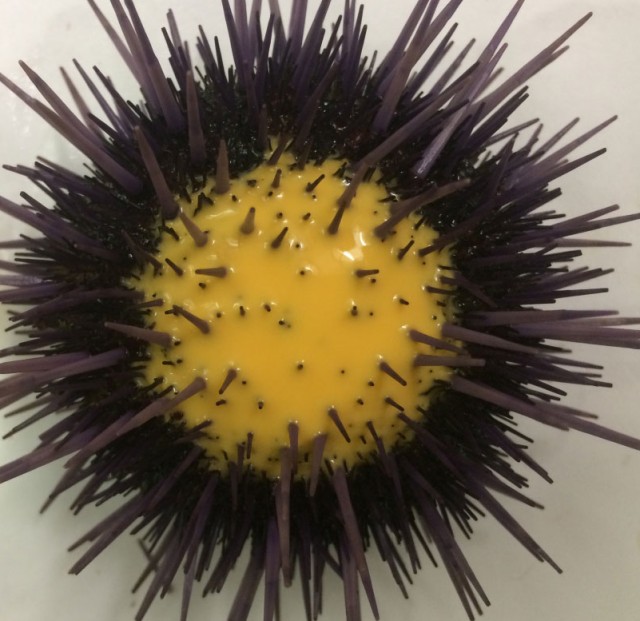Rapid Adaptation

Biologists discover that female purple sea urchins prime their progeny to succeed in the face of stress
By Julie Cohen
This story begins in the kelp forest and ends with a very important climate change message: All is not lost — at least not for purple sea urchins.
A new study by UC Santa Barbara marine biologists demonstrates that for females of the species (Strongylocentrotus purpuratus), exposure to stressful climate conditions such as low pH levels often makes for hardier, larger offspring. The group’s findings appear in the journal Molecular Ecology.
“We’ve known that these things go on in fish and other species, but we’ve never studied this in the context of climate change in the marine ecology of kelp forests,” said co-author Gretchen Hofmann, chair of UCSB’s Department of Ecology, Evolution, and Marine Biology. “This project looked for evidence of rapid adaptation in organisms in response to a changing ocean — and we found it.”
Inspired by dynamic shifts in pH due to upwelling — the movement of nutrient-rich water toward the ocean surface — the researchers took urchins from the Santa Barbara Channel and brought them into the lab. The animals were held for about four months while the females made ripe eggs — a process called gametogenesis. When they spawned and were fertilized, the investigators tested the embryos.
Two groups of urchins were held at different pH levels — one that was low pH, akin to ocean acidification conditions, and another that mimicked normal non-upwelling pH conditions. The researchers then compared the progeny of the two groups.
“It was more dramatic than we expected,” Hofmann said. “It’s almost like the female could sense that her progeny were about to be released into some challenging conditions for early-stage development. In response, she primed her offspring and gave them tools to face stressful conditions. It’s like she packed them a backpack of tools, including extra lipids.”

Using next-generation sequencing technology, the scientists examined the transcriptome — every gene activated in the embryo — to create a snapshot of how baby urchins responded physiologically.
“The two groups were radically different,” said lead author Juliet Wong, a graduate student in the Hofmann Lab. “Urchin larvae from females exposed to low pH conditions had more genes turned on and were better prepared to handle stress. We were pretty surprised to see that.”
One of the mechanisms driving alterations in gene expression is epigenetic change, where the female is able to change her offspring’s genome to cause certain genes to be expressed differently.
“This work shows that a rapid adaptation response is likely possible in many organisms,” Hofmann explained. “We just haven’t looked at these transgenerational or maternal effects in a climate change context before. Because purple sea urchin females can condition their progeny to experience future stress, the urchins have tools at hand to respond to changes like ocean acidification.”
Researchers worldwide are studying how these types of mechanisms might work in other marine organisms such as tropical corals threatened by ocean warming. For Hofmann’s team, the next step is more closely examining the genome-to-phenotype transition and attempting to replicate these new findings in the ocean.
Members of the lab are already starting field experiments to test whether or not these epigenetics play out in local kelp forests, as part of research within the Santa Barbara Coastal Long Term Ecological Research project.
“For now,” Hofmann said, “we know that female urchins are able to prepare their offspring to experience harsher conditions — more so than we ever thought — so our results are somewhat hopeful.”
“This important study tests the mechanisms that determine how organisms are likely to respond to ocean acidification in natural settings,” said David Garrison, program director in the National Science Foundation’s Division of Ocean Sciences, which funded the research.